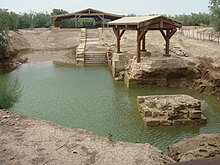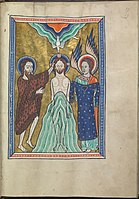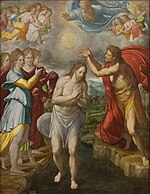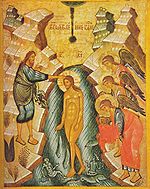What Does It Mean That Jesus Had to Be Baptized in Order â€å“to Fulfill All Righteousnessã¢â‚¬â?
 The Baptism of Christ by Andrea del Verrocchio and Leonardo da Vinci, c. 1475 | |
| Engagement | Early 1st century AD |
|---|---|
| Location | Present-day Al-Maghtas, Jordan |
| Participants | Jesus, John the Baptist |
The baptism of Jesus by John the Baptist is a major event in the life of Jesus which is described in three of the gospels: Matthew, Mark and Luke.[a] It is considered to have taken place at Al-Maghtas, also chosen Bethany Beyond the Jordan, today located in Jordan.
Modernistic biblical scholars view the baptism of Jesus past John the Baptist as a historical event to which a loftier degree of certainty can exist assigned.[1] [2] [three] [4] [v] Along with the crucifixion of Jesus, biblical scholars view it as one of the two historically certain facts about him, and often use it equally the starting point for the study of the historical Jesus.[6]
The baptism is one of the events in the narrative of the life of Jesus in the canonical Gospels; others include the Transfiguration, Crucifixion, Resurrection, and Rising.[seven] [eight] Most Christian denominations view the baptism of Jesus every bit an important event and a basis for the Christian rite of baptism (run across besides Acts 19:i–7). In Eastern Christianity, Jesus' baptism is commemorated on 6 January (the Julian calendar date of which corresponds to xix January on the Gregorian calendar), the feast of Epiphany.[ix] In the Roman Catholic Church building, the Anglican Communion, the Lutheran Churches and some other Western denominations, it is recalled on a day within the following calendar week, the banquet of the baptism of the Lord. In Roman Catholicism, the baptism of Jesus is 1 of the Luminous Mysteries sometimes added to the Rosary. It is a Trinitarian banquet in the Eastern Orthodox Churches.
In the Synoptic Gospels [edit]
Mark, Matthew, and Luke depict the baptism in parallel passages. In all iii gospels, the Holy Spirit is depicted as descending upon Jesus immediately after his baptism accompanied by a vocalism from Heaven, but the accounts of Luke and Marker record the voice as addressing Jesus past proverb "Yous are my dearest Son, in whom I am well pleased", while in Matthew the voice states "This is my beloved Son, in whom I am well pleased" (Matthew 3:13–17; Marker ane:nine–11; Luke 3:21–23).[10] [11] [12]
After the baptism, the Synoptic gospels depict the temptation of Jesus, where Jesus withdrew to the Judean desert to fast for 40 days and nights.
Matthew [edit]
In Matthew 3:14, upon meeting Jesus, John said: "I have need to be baptized of thee, and comest one thousand to me?" Withal, Jesus convinces John to baptize him even so.[12] Matthew records that the voice from heaven says "This is my dear Son, in whom I am well pleased", simply does non indicate who is addressed.
Mark [edit]
Mark's account is roughly parallel to that of Matthew, except for Matthew iii:14–xv describing John's initial reluctance and eventual consent to baptize Jesus, which is not described by Marker. Marking uses an unusual give-and-take for the opening of the heavens, Greek: σχιζομένους, schizomenous, which means "fierce" or "ripping" (Mark ane:10). It forms a exact thread (Leitwortstil) with the rending (ἐσχίσθη, eschisthē) of the Temple veil in Mark 15:38, inviting comparison between the two episodes.[13]
Luke [edit]
Luke 1 begins with the nascency of John the Baptist, heralded to his father Zacharias by the affections Gabriel. Six months later Gabriel appears to the Virgin Mary with an announcement of the birth of Jesus, at the Annunciation. At the same, Gabriel as well announces to Mary the coming birth of John the Baptist, to her kinswoman Elizabeth, who is the wife of Zacharias. Mary immediately sets out to visit her kinswoman Elizabeth, and stays with her until John's birth. Luke strongly contrasts the reactions of Zacharias and Mary to these 2 corresponding births; and the lives of John and Jesus are intertwined.
Luke uniquely depicts John as showing public kindness to tax collectors and encouraging the giving of alms to the poor (equally in Luke iii:eleven). Luke records that Jesus was praying when Heaven was opened and the Holy Spirit descended on him. Luke clarifies that the spirit descended in the "bodily form" of a dove, equally opposed to merely "descending like" a dove. In Acts 10:37–38, the ministry of Jesus is described equally following "the baptism which John preached".[xiv]
In the Gospel of John [edit]

In John 1:29–33 rather than a direct narrative, John the Baptist bears witness to the spirit descending like a dove.[10] [16]
The Gospel of John (John 1:28) specifies "Bethabara across Jordan", i.e., Bethany in Perea as the location where John was baptizing when Jesus began choosing disciples, and in John 3:23 in that location is mention of further baptisms in Ænon "because in that location was much water there".[17] [18]
John 1:35–37 narrates an run across, between Jesus and two of his future disciples, who were then disciples of John the Baptist.[nineteen] [xx] The episode in John 1:35–37 forms the start of the human relationship between Jesus and his time to come disciples. When John the Baptist chosen Jesus the Lamb of God, the "two disciples heard him speak, and they followed Jesus".[14] [21] [22] One of the disciples is named Andrew, merely the other remains unnamed, and Raymond E. Brown raises the question of his being the author of the Gospel of John himself.[16] [23] In the Gospel of John, the disciples follow Jesus thereafter, and bring other disciples to him, and Acts 18:24–19:6 portrays the disciples of John equally somewhen merging with the followers of Jesus.[16] [xix]
In the Gospel of the Nazarenes [edit]
According to the non-approved Gospel of the Nazarenes, the idea of being baptized by John came from the female parent and brothers of Jesus, and Jesus himself, originally opposed, reluctantly accepted it.[24] Benjamin Urrutia avers that this version is supported past the criterion of embarrassment, since followers of Jesus would not have invented an episode in which Jesus changes his mind and comes to have someone else's plan. Plus, the story came from the community that included the family of Jesus, who would have guaranteed the authenticity of the narrative.[25]
Location [edit]

Part of the ancient Madaba Map showing Bethabara due east of the Jordan River

The Gospel of John (John one:28) states that John was baptising in "Bethany Across the Hashemite kingdom of jordan".[17] [18] generally considered to be the town of Bethany, likewise chosen Bethabara in Perea, on the eastern bank of the Jordan river, most Jericho.[xviii] In the 3rd century Origen, who moved to the area from Alexandria, suggested Bethabara as the location.[26] In the quaternary century, Eusebius of Caesarea stated that the location was on the west bank of the Jordan, and following him, the early Byzantine Madaba Map shows Bethabara as (Βέθαβαρά).[26]
The biblical baptising is related to springs and a Wadi (al-Kharrar) close to the Eastern site of the Jordan River,[27] non the Jordan itself.[28] The pilgrimage sites, important for both Christians and Jews have shifted place during history. The site of Al-Maghtas (baptism, or immersion in Arabic) on the East side of the River in Jordan has been deemed the earliest place of worship. This site was found following UNESCO-sponsored excavations.[29] Al-Maghtas was visited by Pope John Paul Two in March 2000, and he said: "In my mind I meet Jesus coming to the waters of the river Jordan non far from here to exist baptized past John the Baptist".[30] The Muslim conquest put an cease to the Byzantine buildings on the east depository financial institution of the Jordan River, the after reverence took place just across the river in the West Banking concern at Qasr el Yahud.[31] The valley effectually the Dead Sea, which the Jordan River flows into from the Due north, is also the lowest place on planet Globe.[32]
Chronology [edit]
The baptism of Jesus is generally considered as the start of his ministry, soon after the start of the ministry of John the Baptist.[33] [34] [35] Luke 3:1–2 states that:[36] [37]
In the fifteenth year of the reign of Tiberius Caesar—when Pontius Pilate was governor of Judea ... , the word of God came to John son of Zechariah in the wilderness.
There are two approaches to determining when the reign of Tiberius Caesar started.[38] The traditional approach is that of bold that the reign of Tiberius started when he became co-regent in 11 AD, placing the start of the ministry of John the Baptist effectually 26 Ad. However, some scholars assume it to exist upon the death of his predecessor Augustus Caesar in xiv AD, implying that the ministry building of John the Baptist began in 29 Advertisement.[38]
The generally assumed dates for the start of the ministry of John the Baptist based on this reference in the Gospel of Luke are most 28–29 Advertisement, with the ministry of Jesus with his baptism following it shortly thereafter.[36] [37] [39] [xl] [41]
Historicity [edit]

Most modern scholars believe that John the Baptist performed a baptism on Jesus, and view it as a historical event to which a high degree of certainty tin exist assigned.[1] [2] [3] [4] James Dunn states that the historicity of the baptism and crucifixion of Jesus "control almost universal assent".[six] Dunn states that these 2 facts "rank and then high on the 'almost impossible to doubt or deny' scale of historical facts" that they are often the starting points for the written report of the historical Jesus.[6] John Dominic Crossan states that it is historically certain that Jesus was baptised by John in the Jordan.[5]
In the Antiquities of the Jews (18.5.2) 1st-century historian Flavius Josephus also wrote about John the Baptist and his eventual decease in Perea.[42] [43]
The existence of John the Baptist within the aforementioned time frame as Jesus, and his eventual execution by Herod Antipas, is attested to by 1st-century historian Flavius Josephus and the overwhelming majority of modern scholars view Josephus' accounts of the activities of John the Baptist equally authentic.[44] [45] Josephus establishes a key connection betwixt the historical events he recorded and specific episodes that appear in the gospels.[44] The reference in the Antiquities of the Jews past Josephus to John'south popularity amid the crowds (Ant eighteen.5.two) and how he preached his baptism is considered a reliable historical datum.[46] [47] Unlike the gospels, Josephus does not relate John and Jesus, and does not country that John'south baptisms were for the remission of sins.[46] [47] [48] However, most all modern scholars consider the Josephus passage on John to exist accurate in its entirety and view the variations between Josephus and the gospels every bit indications that the Josephus passages are authentic, for a Christian interpolator would have fabricated them correspond to the Christian traditions.[49] [50]
One of the arguments in favour of the historicity of the baptism of Jesus by John is that it is a story which the early Christian Church would have never wanted to invent, typically referred to as the criterion of embarrassment in historical analysis.[4] [five] [51] Based on this criterion, given that John baptised for the remission of sins, and Jesus was viewed as without sin, the invention of this story would accept served no purpose, and would have been an embarrassment given that it positioned John to a higher place Jesus.[iv] [51] [52] The Gospel of Matthew attempts to first this trouble past having John feel unworthy to baptise Jesus and Jesus giving him permission to do so in Matthew iii:fourteen–xv.[53]
The gospels are not the merely references to the baptisms performed by John and in Acts 10:37–38, the apostle Peter refers to how the ministry of Jesus followed "the baptism which John preached".[54] Another argument used in favour of the historicity of the baptism is that multiple accounts refer to information technology, usually called the criterion of multiple attestation.[53] Technically, multiple attestation does non guarantee authenticity, but only determines artifact.[55] However, for most scholars, together with the criterion of embarrassment information technology lends credibility to the baptism of Jesus by John being a historical event.[53] [56] [57] [58]
Artistic depictions [edit]
While the gospel of Luke is explicit almost the Spirit of God descending in the shape of a dove, the wording of Matthew is vague plenty that it could be interpreted only to suggest that the descent was in the style of a dove. Although a diverseness of symbolisms were attached to doves at the time these passages were written, the dove imagery has get a well known symbol for the Holy Spirit in Christian art.[59] [threescore] Depictions of the baptismal scene typically show the sky opening and the Holy Spirit descending as a dove towards Jesus.[61]
Artists usually tried to testify the whole body of Christ as he stood in the water, which could give them difficulties. The reasonably coherent 6th-century mosaic image in the Arian Baptistry, Ravenna, with the h2o hemmed in past two banks, when used in many generations of copies in Western Europe, by artists unskilled in depicting visual recession, led to images like that in the Psalter of Eleanor of Aquitaine, where at that place appears to be a continuing mound of water.
At least one attendant archangel, holding Christ's robe, and often some other with a towel, became usual in medieval images.
-

Miniature from the Psalter of Eleanor of Aquitaine (ca. 1185)
-

-

-

-

-

-

Relief in Kärlich, around the 17th century
-

-

-

Giovanni Battista Tiepolo, Baptism of Christ, 18th century, Italia
Music [edit]
The reformer Martin Luther wrote a hymn about baptism, based on biblical accounts about the baptism of Jesus, "Christ unser Herr zum Hashemite kingdom of jordan kam" (1541). It is the basis for a cantata by Johann Sebastian Bach, Christ unser Herr zum Jordan kam, BWV 7 , showtime performed on 24 June 1724.
See also [edit]
- Ænon
- Al Maghtas
- Bethabara
- Chronology of Jesus
- Jesus in Christianity
- Life of Jesus in the New Testament
- Mandaeism
- Ministry of Jesus
- New Attestation places associated with Jesus
- Qasr el Yahud
- Transfiguration of Jesus
Notes [edit]
- ^ The Gospel of John does not straight depict Jesus' baptism.
Information technology is traditionally historic on the Dominicus after Epiphany, oscillating between January 7 and 13, notwithstanding, different episcopal conferences celebrate information technology in the same way, but the difference is that this party is only celebrated on the Sunday later on Epiphany, oscillating betwixt the 9 and on Jan 13, if Christmas falls on Monday, Holy Family on December 31, the Solemnity of Saint Mary, Mother of God on Mon, this banquet volition be celebrated on Monday, eight January and if Christmas falls on Sun, the Solemnity of Saint Mary, Mother of God on Sunday, this banquet happens to be historic on Monday, January 9.
References [edit]
- ^ a b The Gospel of Matthew by Daniel J. Harrington 1991 ISBN 0-8146-5803-2 p. 63
- ^ a b Christianity: A Biblical, Historical, and Theological Guide by Glenn Jonas, Kathryn Muller Lopez 2010, pp. 95–96
- ^ a b Studying the Historical Jesus: Evaluations of the State of Current Inquiry by Bruce Chilton, Craig A. Evans 1998 ISBN xc-04-11142-5 pp. 187–98
- ^ a b c d Jesus as a Effigy in History: How Mod Historians View the Homo from Galilee by Marker Allan Powell 1998 ISBN 0-664-25703-8 p. 47
- ^ a b c Who Is Jesus? by John Dominic Crossan, Richard Thousand. Watts 1999 ISBN 0-664-25842-5 pp. 31–32
- ^ a b c Jesus Remembered past James D. G. Dunn 2003 ISBN 0-8028-3931-2 p. 339
- ^ Essays in New Testament Estimation past Charles Francis Digby Moule 1982 ISBN 0-521-23783-1 p. 63
- ^ The Tune of Faith: Theology in an Orthodox Key by Vigen Guroian 2010 ISBN 0-8028-6496-i p. 28
- ^ Богоявление и Рождество Христово
- ^ a b Jesus of History, Christ of Faith by Thomas Zanzig 2000 ISBN 0-88489-530-0 p. 118
- ^ Eerdmans Commentary on the Bible by James D. G. Dunn, John William Rogerson 2003 ISBN 0-8028-3711-5 p. 1010
- ^ a b The Synoptics: Matthew, Marker, Luke by Ján Majerník, Joseph Ponessa, Laurie Watson Manhardt 2005 ISBN i-931018-31-6 pp. 27–31
- ^ David Rhoads, Joanna Dewey, and Donald Michie 2012, Mark equally Story: An Introduction to the Narrative of a Gospel, 3rd ed. Minneapolis, MN: Fortress Printing, 48.
- ^ a b Jesus of Nazareth past Duane S. Crowther 1999 ISBN 0-88290-656-9 p. 77
- ^ The Lamb of God past Sergei Bulgakov 2008 ISBN 0-8028-2779-9 p. 263
- ^ a b c The Gospel and Epistles of John: A Curtailed Commentary by Raymond Edward Brown 1988 ISBN 978-0-8146-1283-v pp. 25–27
- ^ a b Big Picture of the Bible – New Testament past Lorna Daniels Nichols 2009 ISBN 1-57921-928-iv p. 12
- ^ a b c John past Gerard Stephen Sloyan 1987 ISBN 0-8042-3125-vii p. xi
- ^ a b The People'due south New Testament Commentary by Eugene M. Tiresome and Fred B. Craddock 2010, Westminster John Knox Press ISBN 0-664-23592-1 pp. 292–93
- ^ New Testament History by Richard L. Niswonger 1992 ISBN 0-310-31201-ix pp. 143–46
- ^ The Life and Ministry building of Jesus: The Gospels past Douglas Redford 2007 ISBN 0-7847-1900-4 p. 92
- ^ A Summary of Christian History past Robert A. Baker, John Thou. Landers 2005 ISBN 0-8054-3288-four pp. six–7
- ^ The Disciple Whom Jesus Loved by J. Phillips 2004 ISBN 0-9702687-i-viii pp. 121–23
- ^ Jerome, quoting "The Gospel According to the Hebrews" in Dialogue Against Pelagius Iii:two.
- ^ Guy Davenport and Benjamin Urrutia, The Logia of Yeshua / The Sayings of Jesus (1996), ISBN 1-887178-70-8 p. 51.
- ^ a b Jesus and Archeology by James H. Charlesworth 2006, Eedrsmans ISBN 0-8028-4880-Ten pp. 437–39
- ^ The Synoptics past Jan Majernik, Joseph Ponessa and Laurie Manhardt 2005 ISBN 1-931018-31-half-dozen p. 29
- ^ "Wo Johannes taufte". ZEIT ONLINE. Rosemarie Noack. 22 December 1999. Retrieved ix December 2015.
- ^ Staff writers (28 July 2011). "Israel will reopen (Israeli) site of the baptism of Jesus". AsiaNews.it . Retrieved 31 July 2011.
- ^ Vatican website: Accost of John Paul II at Al-Maghtas Archived 16 July 2012 at the Wayback Automobile
- ^ "No prove, simply United nations says Jesus baptized on Jordan's side of river, not Israel'south". The Times of Israel. 13 July 2015. Retrieved 26 November 2015.
- ^ "Lowest Places on Earth - Decease Valley National Park (U.S. National Park Service)". www.nps.gov . Retrieved 14 September 2020.
- ^ Jesus and the Gospels: An Introduction and Survey past Craig L. Blomberg 2009 ISBN 0-8054-4482-3 pp. 224–29
- ^ Christianity: An Introduction by Alister E. McGrath 2006 ISBN 978-1-4051-0901-7pp. 16–22
- ^ The Cradle, the Cross, and the Crown: An Introduction to the New Attestation by Andreas J. Köstenberger, L. Scott Kellum 2009 ISBN 978-0-8054-4365-3 po. 140–41
- ^ a b Eerdmans Dictionary of the Bible 2000 Amsterdam Academy Press ISBN 90-5356-503-5 p. 249
- ^ a b The Bible Knowledge Groundwork Commentary: Matthew-Luke, Book i by Craig A. Evans 2003 ISBN 0-7814-3868-3 pp. 67–69
- ^ a b Luke 1–5: New Attestation Commentary by John MacArthur 2009 ISBN 0-8024-0871-0 p. 201
- ^ The Cradle, the Cross, and the Crown: An Introduction to the New Testament by Andreas J. Köstenberger, Fifty. Scott Kellum 2009 ISBN 978-0-8054-4365-three p. 114
- ^ Christianity and the Roman Empire: Groundwork Texts past Ralph Martin Novak 2001 ISBN 1-56338-347-0 pp. 302–03
- ^ Hoehner, Harold W (1978). Chronological Aspects of the Life of Christ. Zondervan. pp. 29–37. ISBN0-310-26211-9.
- ^ Eerdmans Dictionary of the Bible 2000 ISBN 90-5356-503-5 p. 583
- ^ Behold the Homo: The Existent Life of the Historical Jesus by Kirk Kimball 2002 ISBN 978-1-58112-633-iv p. 654
- ^ a b Craig Evans, 2006 "Josephus on John the Baptist" in The Historical Jesus in Context edited by Amy-Jill Levine et al. Princeton Univ Press ISBN 978-0-691-00992-6 pp. 55–58
- ^ The New Complete Works of Josephus by Flavius Josephus, William Whiston, Paul L. Maier ISBN 0-8254-2924-ii pp. 662–63
- ^ a b John the Baptist: Prophet of Purity for a New Age by Catherine M. White potato 2003 ISBN 0-8146-5933-0 p. 53
- ^ a b Jesus & the Ascent of Early Christianity: A History of New Testament Times by Paul Barnett 2009 ISBN 0-8308-2699-viii p. 122
- ^ Claudia Setzer, "Jewish Responses to Believers in Jesus", in Amy-Jill Levine, Marc Z. Brettler (editors), The Jewish Annotated New Testament, p. 576 (New Revised Standard Version, Oxford University Press, 2011). ISBN 978-0-nineteen-529770-6
- ^ Evans, Craig A. (2006). "Josephus on John the Baptist". In Levine, Amy-Jill. The Historical Jesus in Context. Princeton Univ Printing. ISBN 978-0-691-00992-half dozen. pp. 55–58
- ^ Eddy, Paul; Boyd, Gregory (2007). The Jesus Legend: A Case for the Historical Reliability of the Synoptic Jesus Tradition. ISBN 0-8010-3114-ane. p. 130
- ^ a b Jesus of Nazareth: An Contained Historian's Account of His Life and Teaching by Maurice Casey 2010 ISBN 0-567-64517-seven p. 35
- ^ The Historical Jesus: a Comprehensive Guide past Gerd Theissen, Annette Merz 1998 ISBN 0-8006-3122-6 p. 207
- ^ a b c John the Baptist: Prophet of Purity for a New Age by Catherine M. Murphy 2003 ISBN 0-8146-5933-0 pp. 29–30
- ^ Who is Jesus?: An Introduction to Christology by Thomas P. Rausch 2003 ISBN 978-0-8146-5078-3 p. 77
- ^ Jesus and His Contemporaries: Comparative Studies by Craig A. Evans 2001 ISBN 0-391-04118-5 p. 15
- ^ An Introduction to the New Testament and the Origins of Christianity past Delbert Royce Burkett 2002 ISBN 0-521-00720-8 pp. 247–48
- ^ Who is Jesus? by Thomas P. Rausch 2003 ISBN 978-0-8146-5078-3 p. 36
- ^ The Human relationship between John the Baptist and Jesus of Nazareth: A Critical Written report by Daniel S. Dapaah 2005 ISBN 0-7618-3109-6 p. 91
- ^ Clarke, Howard W. The Gospel of Matthew and its Readers: A Historical Introduction to the Start Gospel. Bloomington: Indiana University Press, 2003.
- ^ Albright, W.F. and C.S. Mann. "Matthew". The Ballast Bible Series. New York: Doubleday & Company, 1971.
- ^ Medieval Fine art: A Topical Dictionary by Leslie Ross 1996 ISBN 978-0-313-29329-0 p. 30
External links [edit]
- Baptism of Jesus – Cosmic Encyclopedia
Source: https://en.wikipedia.org/wiki/Baptism_of_Jesus